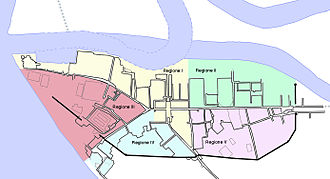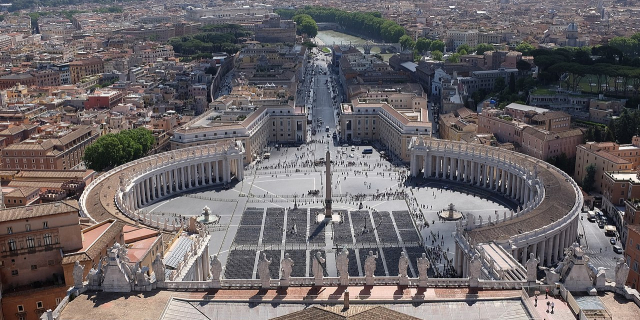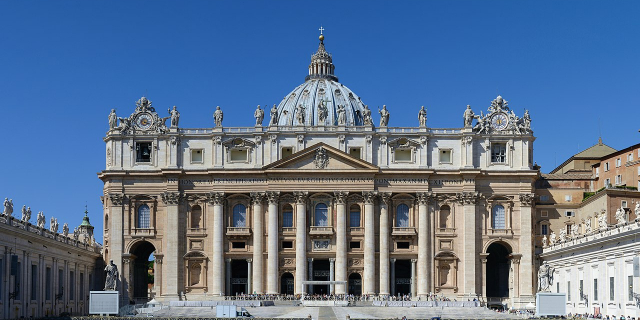Ostia (città antica)
( Ostia Antica )Ostia Antica (lit. 'Ancient Ostia') was an ancient Roman city and the port of Rome located at the mouth of the Tiber. It is near modern Ostia, 25 km (16 mi)) southwest of Rome. Due to silting and the invasion of sand, the site now lies 3 km (2 mi) from the sea. The name Ostia (the plural of ostium) derives from Latin os 'mouth'.
Ostia is now a large archaeological site noted for the excellent preservation of its ancient buildings, magnificent frescoes and impressive mosaics. The city's decline after antiquity led to harbor deterioration, marshy conditions, and reduced population. Sand dunes covering the site aided its preservation. Its remains provide insights into a city of commercial importance. As in Pompeii, Ostia's ruins provide details about Roman urbanism that are not accessible within the city of Rome itself.
Ostia may have been Rome's first colonia. According to legend, Ancus Marcius, the fourth king of Rome, was the first to destroy Ficana, an ancient town that was only 17 km (11 mi) from Rome and had a small harbour on the Tiber, and then proceeded with establishing the new colony 10 km (6 mi) further west and closer to the sea coast. An inscription seems to confirm the establishment of the old castrum of Ostia in the 7th century BC.[1] The oldest archaeological remains so far discovered date back to only the 4th century BC.[2] The most ancient buildings currently visible are from the 3rd century BC, notably the Castrum (military camp);[3] of a slightly later date is the Capitolium (temple of Jupiter, Juno and Minerva). The opus quadratum of the walls of the original castrum at Ostia provide important evidence for the building techniques that were employed in Roman urbanisation during the period of the Middle Republic.[4]
Ostia probably developed originally as a naval base, and in 267 BC, during the first Punic war, it was the seat of the quaestor Ostiensis in charge of the fleet. During the 2nd century BC its role as a commercial port gradually became prevalent for the imports of grain for the city of Rome, and buildings began to spread outside the castrum.
Civil warsOstia was a scene of fighting during the period of civil wars in the 80s BC. In 87 BC Marius attacked the city in order to cut off the flow of trade to Rome, aided by his generals Cinna, Carbo and Sertorius, and captured the city and plundered it.[5]
Sacking by piratesIn 68 BC, the town was sacked by pirates during which,[6] the port was set on fire, the consular war fleet was destroyed, and two prominent senators were kidnapped. This attack caused such panic in Rome that Pompey the Great arranged for the tribune Aulus Gabinius to pass a law, the lex Gabinia, to allow Pompey to raise an army and destroy the pirates. Within a year, the pirates had been defeated.[7]
The town was then re-built and provided with defensive walls started under Marcus Tullius Cicero according to an inscription.[8][9]
Imperial Ostia Map of Ostia Antica
Map of Ostia Antica View of the Forum from the Theatre
View of the Forum from the Theatre The Ancient Roman theatre
The Ancient Roman theatreThe town was further developed during the first century AD under the influence of Tiberius, who ordered the building of the town's first forum.
Due to the small size of the harbour at Ostia, a new harbour at Portus was built by Claudius on the northern mouths of the Tiber (Fiumara Grande). This harbour was not sufficiently protected from storms, and needed to be supplemented by the hexagonal harbour built by Trajan and finished in 113 AD.[10] Also at a relatively short distance was the harbour of Civitavecchia (Centum Cellae) developed by Trajan. These ports took business away from Ostia and began its commercial decline.[10]
Nevertheless, Ostia grew to a peak of some 100,000 inhabitants in the 2nd and 3rd centuries AD.[11]
Ostia itself was provided with all the services a town of the time could require; a large theatre, many public baths (such as the Thermae Gavii Maximi, or Baths at Ostia), numerous taverns and inns and a firefighting service. The popularity of the cult of Mithras is evident in the discovery of eighteen Mithraea.[12] Ostia also contained the Ostia Synagogue, the earliest synagogue yet identified in Europe.[13]
Late-Roman and sub-Roman Ostia Via di Diana
Via di DianaAlthough it used to be thought that the city entered a period of slow decline after Constantine the Great made Portus a municipality, indicated by some apartment blocks being replaced by houses of the rich, recent excavations show that the town continued to thrive.[14] Numerous baths are recorded as still operating in the 4th and 5th centuries with major repairs of the city's Neptune Baths in the 370s. During the 4th century, the city spilled over the southern walls to the sea south of Regions III and IV.
The poet Rutilius Namatianus reported the lack of maintenance of the city ports in 414 AD.[15] This view has been challenged by Boin who states Namatianus' verse is a literary construct and inconsistent with the archaeological record.[16]
Prosperity in the 5th century is indicated by repairs on baths (26 remained in operation during the 4th century), public buildings, church construction, street repaving, residential and business expansion beyond the perimeter of the south wall (the presence of a small harbour, the Porta Marina on the sea, is attested). A huge 4th century villa east of the Maritime baths was built. The river port on the western edge of the town was expanded with the navalia, a squarish basin built in from the river. A warehouse on the east side and, behind it, a large bath complex were built.[17]
It became an episcopal see as part of the Diocese of Rome as early as the 3rd century AD. The city was mentioned by St Augustine when he passed there in the late 4th century.[18] On their way back to Africa after Augustine's conversion to Christianity, Augustine's mother, Saint Monica, died in 387 in Ostia.[19] The church (titulus) of Santa Aurea in Ostia was built on her burial site.
After the fall of the Western Roman Empire in 476, Ostia fell slowly into decay as the population of Rome, 700–800,000 in AD 400 contracted to 200,000 or less in 500 AD. A naval battle, the Battle of Ostia, was fought there in 849 between Christians and Saracens; the remaining inhabitants moved to Gregoriopolis a short distance away.[10]






























Add new comment